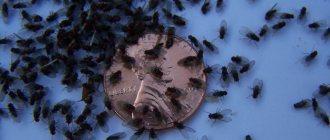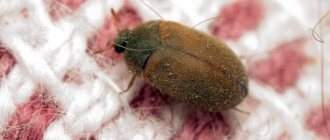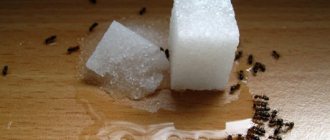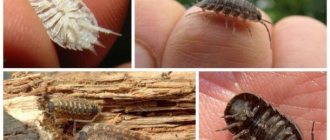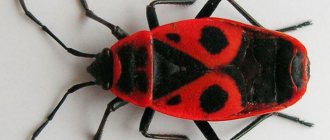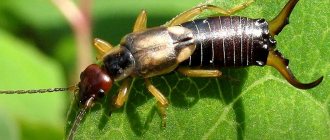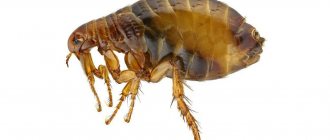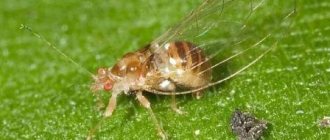- Posted by Natalia Slovina
- Date: March 30, 2017
In fairy tales, crickets are always positive heroes; many good omens are associated with them. That is why in life a person’s attitude towards these insects is good-natured and condescending.
- 2 Why and where do these insects appear in an apartment or house?
- 3 How to get rid of crickets (with reviews)
3.1 Traps
- 3.2 Traditional recipes
- 3.3 Chemicals
3.3.1 Comparative characteristics of methods to combat crickets
Description and features of the insect
The cricket, which lived in the desert climate of Asia and Africa, quickly spread across all continents.
Appearance
The length of the body of a bug with developed and strong wings does not exceed 2.5 cm. Insects have different colors, some individuals are very light, others have a dark brown tint. Of the three pairs of legs, the hind limbs are designed for jumping. The female cricket lays several hundred eggs, from which wingless larvae emerge. The insect lives up to 4 months and then dies.
How to recognize by sound
Warmth and food attract bugs to human homes. The monotonous trills emitted by crickets at night when they are awake are very annoying, but catching a moving insect is not easy.
How and why they sing
With sounds that prevent people from getting enough sleep, males lure females during the mating season and mark the boundaries of the territory so that the enemy does not lay claim to it. There are folds on the insect's wings that vibrate when they touch, producing a chirping sound.
What does a cricket look like, photo
Once insects become people’s neighbors in an apartment or house, everything changes. Not everyone likes the night trills, and in appearance the insects are more reminiscent of the less pleasant cockroaches.
The house cricket looks similar to the Prussian cockroach
The house cricket is a small insect. The body is slender, slightly flattened. It is covered by a hard shell ranging from grayish-yellow and straw-fawn to fairly dark shades of brown with specks, streaks and spots.
On the sides of the ovoid, flattened head are small eyes. Long antennae often exceed the size of the owner himself. The insect has well-developed wings. There are 3 pairs of legs. Thanks to the special structure of their hind legs, crickets can jump well. A characteristic feature of insects is the ability to produce specific trills and crickets.
Reasons for appearance
In the south, crickets are comfortable in natural conditions; in the northern regions and temperate latitudes, by the fall the bugs move to heating mains, basements, and spend the winter in houses and apartments.
Light
Although crickets sleep during the day, having found a secluded place, they become active at night, hunt for food, fight with enemies who have come to their territory, and bright light attracts singing insects to people’s homes.
See also
Step-by-step instructions on how to replace the cartridge in a chandelier with your own hands
Smell of garbage
Leftover food in a warm room quickly begins to rot; crickets, sensing a specific aroma, head to the place where the smell comes from, since they are not averse to eating spoiled food.
High humidity
Even insects that have lived for a long time in the desert regions of Asia and Africa, where it is dry and hot, with virtually no rain, strive to find moisture, and find it in basements and houses.
Open windows
Crickets easily crawl into microscopic cracks and open windows and doors attract curious insects.
Who are crickets and where do they come from in the house?
The cricket belongs to insects from the Orthoptera family (genus crickets), its homeland is northern Africa and the Far East. These insects, of which there are about 40 species in our country, are divided into field and domestic. Naturally, house crickets, whose chirping often disturbs sleep, cause concern.
If wild crickets dig a hole for themselves, reaching a length of up to 30 cm, then domestic ones prefer to live in warm and dark places, mainly near heating devices. The insect is nocturnal and can only be heard at night. Only males can chirp.
Cricket fighting is especially popular in Asian countries.
Often the reasons why crickets are brought into a home are heat (temperature from 20 ° C) and high humidity. Without these conditions, insects become inactive, lose their ability to reproduce, and stop feeding. And also the development and growth of larvae stops.
Crickets appear in the house from boiler rooms and basements, easily penetrating through ventilation grilles, cracks in doors and windows. For laying, crickets choose the space behind the tiles, cracks in the plaster, the underside of old wallpaper, books, the back wall of furniture, cracks between the baseboard and the floor, and ventilation ducts. Adults live under the sink, near heating appliances in dark places, etc.
Do not create conditions for the appearance of crickets: do not overdo it with heating devices
House crickets feed on:
- food of plant origin;
- cockroaches;
- leftovers from the table;
- other invertebrates;
- own clutch and young larvae.
If there is only one cricket, then its appearance, as a rule, does not threaten anything. But with his songs he can attract females, and then their number and noise will increase.
During the nesting and breeding stages, crickets damage paper products, furniture, walls and even clothing
. As in nature, they dig holes for eggs. Only they do this not in the ground, but in things, gnawing holes in book sheets, sofas, etc.
Methods of disposal
If the monotonous melody that is heard every night drives you crazy, a person forgets about the signs and dreams only that the singing will finally stop. However, annoying bugs sense even the slightest vibration in the air and hide in cracks where they cannot be reached.
Traditional methods
It is possible to cope with crickets without the use of poison and chemicals that are dangerous for household members. Since ancient times, people have known recipes to help remove insects.
Feed molasses and lemon balm
The bugs are not averse to eating food, they love sweets, but they are very fast and hide in a crack when they see a person. Crickets are lured by pouring molasses into a deep bowl. Insects will climb up there to taste the delicacy; bugs are unable to climb out.
Burning wax
The easiest way to determine the exact place that the candles have chosen is by the monotonous sounds made by the males. To force insects to leave the house, you need to light sealing wax near the crack where the uninvited guests have settled. The resins present in it are not tolerated by crickets.
Close all water sources
Insects usually settle in the bathtub or kitchen near the taps because they love moisture. Bugs feel uncomfortable in a dry room. Without access to water for a long time, they die.
Chemicals
If folk recipes do not give a positive result, and the crickets continue to irritate with their chirping, more stringent measures have to be taken.
Lures
When insects begin to multiply, pyrethrum powder, which can be purchased at a pharmacy, is poured into the places where they are most numerous. To lure crickets, place a saucer or plate of milk at the bottom of the container, into which sweet corn flakes are poured. Alcohol is poured into the upper compartment. The bugs will not refuse the treat, but will die from the fumes of the medicine.
Sticky strips
Adhesive tape helps to cope with crickets and annoying monotonous sounds. It is hung in different places in the house.
See also
How to properly plant an item made from various materials, step-by-step instructions and recommendations
Mechanical method
The safest way to kill a cricket is to hit the insect with any object at hand, but hitting a fast bug is not so easy.
Vacuum cleaner
To combat annoying guests, they use household appliances. Since insects crawl into crevices from which they cannot be removed, turn on the vacuum cleaner and pull the crickets into the filter under powerful air pressure.
Jar
People with a weakened psyche cannot stand the monotonous singing of a jumping insect and are trying to find a method that will get rid of the bugs forever. If the crickets have just appeared, upon discovering individuals, you need to cover them with a jar and then destroy them. When there are a large number of insects, neither adhesive tape, nor wormwood infusions, nor sweet traps are very helpful in dealing with the bugs.
Prevention
Fighting crickets constantly is not an option, so you need to know the recommendations to protect your home from the reappearance of the pest:
- seal all cracks and holes through which insects can enter;
- install bird feeders on the porch of the house or on the windowsills;
- move the compost pit and container with household waste as far as possible from the living space;
- change the lighting intensity, making the light less bright;
- periodically measure and control humidity levels;
- promptly mow the grass and remove other growth near the house.
Attention! Following these simple recommendations will prevent insect entry and help maintain sanitary levels.
Despite the apparent simplicity of the prevention methods, they work well and really help to avoid the repeated or initial appearance of the insect on a personal plot or in a living space. Ensuring compliance with the listed standards is very simple; in general, the set of rules is to maintain cleanliness in the living and dining areas. If there is no household waste, there is a high probability that the cricket will not appear.
Effective means to remove
The larvae are destroyed and adults are killed by chemicals, but they are also dangerous for people; when treating places where crickets accumulate, you need to wear gloves and ventilate the house well.
"Doctor Klaus"
The insecticide, produced in the form of an aerosol, copes with wasps and mosquitoes, flies and cockroaches, fleas and crickets. The drug contains active ingredients in the form of:
- synergist;
- lambda-cyhalothrin;
- stabilizer.
The spray is sprayed onto areas where insects are found. The product destroys both larvae and eggs.
"Dichlorvos universal"
Organophosphorus insecticide is sold in aluminum cans ranging from 180 to 500 mg. Aerosol is used to disinfect premises from parasites and insects with closed windows and doors. Spray the area from a distance of 20 cm, do not ventilate the house for 2 hours. "Dichlorvos" contains alkaloids, alcohol, cypermethrin.
The advantages of the insecticide include:
- low cost;
- lack of habituation of insects;
- speed of impact.
A medium package is enough to treat your entire home. The drug destroys all types of parasites.
"Tornado"
The insecticide is sold in plastic bottles in the form of a spray. When sprayed, it kills cockroaches, crickets, and spiders. When working with Tornado, you need to wear gloves and protect your respiratory tract with a respirator.
"Raid"
The aerosol is produced on the basis of organophosphorus compounds and acts on the insect upon contact. The insecticide penetrates the chitinous membrane into the body of the individual and paralyzes the nervous system.
Using a sprayer, the product gets into hard-to-reach places where crickets and bedbugs settle, and leaves no traces after use.
Criterias of choice
Before you start fighting household pests, you need to decide on the choice of disinfestation method. Here the emphasis is on what type of insect is annoying in the apartment, what its number is and how long it has been parasitizing. The safety level of the insecticide should be determined and whether it has an unpleasant odor.
Human safety
All pesticides are divided into highly toxic, moderate and weak. Before using aerosols or insecticide concentrates, you should read the instructions for use of the product. The procedure for treating the premises takes place when the household members leave the apartment. Boric acid, borax, and plants with a strong odor for repelling are safer and more environmentally friendly. But care must be taken to ensure that children do not try these substances or the bitter herb.
Having an unpleasant odor
Many insect repellents have an unpleasant odor. It will make you dizzy if you stay in the house during treatment. With aerosols, the smell quickly disappears. Gels are available with a pleasant aroma or odorless. The plant smells strongly of wormwood, which is often used to repel cockroaches and fleas.
Ease of use
Carrying out pest control in an apartment yourself requires the use of products that are convenient to apply to surfaces. It is not for nothing that sprays in aerosol packages are chosen. They also give preference to ultrasonic devices, which they plug into the network and that’s it.
Destruction of nests
To completely remove insects and prevent a secondary appearance, it is necessary to treat all cracks in the floor or walls, corners where crickets lay eggs, and get rid of the larvae.
What places should you check?
To find the nests of an insect that is annoying with its singing, it is not necessary to thoroughly study its habits or know the cycles and characteristics of reproduction.
See also
Rules and best ways to sew a shirt one size smaller with your own hands
Basement inspection
In hot weather, crickets seek moisture and coolness. In multi-storey buildings there are plenty of areas in which candles feel comfortable. Service workers who are called for disinfection most often find cricket nests in basements.
Gaps in the house
Insects crawl into cracks in walls, floors, and settle in furniture. To find nests, you need to look under sofas, kitchen units, and into every crevice.
Skirting boards
Bugs that appear in an apartment or house begin to multiply and damage furniture and infest food and wooden surfaces. Crickets can be found under baseboards in cracks.
Methods of disposal
Having found insect nests, you should immediately try to destroy them yourself or call a worker from the service that disinfects premises.
Vacuum cleaner at maximum speed
A female cricket lays hundreds of eggs at a time, from which a new generation grows, which produces the next generation.
To destroy nests, you need to turn on the vacuum cleaner at full power and walk through cracks, cracks, and floors.
Specialist
It is more difficult to cope with crickets that have settled in a high-rise building than in a private house. To combat insect nests, in this case, a specialist is invited to disinfect basements, staircases, and treat places where parasites accumulate with special means.
Pet
Cats and dogs have a good sense of smell and often destroy the nests of birds and insects. By monitoring the pet's behavior, the owner can detect a gap inhabited by crickets and destroy them.
Treatment with a special spray
To force the bugs to leave the basement and crawl out from under the baseboards, spray a can of insecticide. Such products are produced in the form of aerosols and sprays and are convenient to use.
What harm do they do?
Crickets are omnivorous and cause enormous damage to garden plants.
In addition to the remains of human food, worms and small insects, the bugs eat leaves and root stems of plants.
They cause the most damage:
- strawberries;
- potatoes;
- corn;
- legumes;
- tobacco;
- wheat;
- rye;
- beans;
- beets;
- carrots;
- onion;
- tomatoes;
- cabbage
In terms of damage, a cricket invasion can be compared to its closest relative, the locust. These insects can leave a gardener without any hope for a harvest in a very short time.
In Asian and African countries, crickets are bred specially. These insects are eaten (their bodies are rich in calcium and protein). They even make chips from them.
Field grasshoppers
They have a laterally compressed body with a fusiform and slightly compressed abdomen at the top. Field grasshoppers are also lobed and large-headed, often lack simple eyes and have tightly compressed lips. The jaws of insects of the group are well developed.
Green grasshopper
Cannot be larger than 7 centimeters in length. The insect is painted green. The color on the wings is especially rich. There are 2 pairs of them. This is a feature of all grasshoppers. They use the first narrow pair of wings to protect the body when at rest and when jumping. The upper wings are wide and are used for flight.
On the wings of a green grasshopper there may be brown along the edge. Large eyes stand out on the insect's muzzle. They are faceted, that is, they are held on the head by a ring of cuticle - a tough but flexible tissue.
There are subspecies of green grasshoppers
. They all hide in the crown of bushes and trees. Therefore, insects do not jump out from under people’s feet. Accordingly, meetings with representatives of the group are rare.
song grasshopper
This is a mini copy of a green grasshopper. The songbird does not grow more than 3.5 centimeters. Another 3 may be on the ovipositor.
The wings of the singing grasshopper end level with the abdomen. Representatives of the green species have wings that protrude significantly.
Gray grasshopper
Grows up to 4 centimeters in length. Appearance of a grasshopper
matches the name. The abundance of brown spots on a green background makes the insect gray when viewed from a distance. Gray grasshoppers are easy to see. They live in field and steppe grasses, easily tolerating the heat.
Due to their prevalence and large size, gray grasshoppers are confused with locusts, which belong to the short antennae suborder. In its name lies the difference between insects.
The antennae of the gray grasshopper are often longer than its body. Locusts have short whiskers. The mechanism of chirping also differs. makes sounds by rubbing its paws together. The grasshopper arches its elytra.
Gray one of the most common types of grasshoppers
Long-nosed grasshopper
Represents the fauna of Europe. The length of the insect does not exceed 6.3 centimeters. The color of the grasshopper is brown-green.
The long-nosed insect is named because of the elongated front part of the muzzle. The grasshopper appears to be equipped with a proboscis.
Grasshopper-leaf
In Latin it is called Elimaea Poaefolia. Among field grasshoppers it has the longest body. It is narrow and green. This allows you to blend in with the blades of grass on which the grasshopper sits.
The leaf grasshopper lives in the Malay Archipelago.
Giant weta
Endemic species, found only in New Zealand. The weta weighs about 70 grams, that is, 2 times more than a sparrow. The length of a well-fed grasshopper reaches 15 centimeters. The rest of the appearance is unremarkable. The insect is colored in beige-brown tones.
The legs of the giant weta are of medium length, the eyes are of medium size, and the mustache is of mediocre length in comparison with the size of the body.
The gigantism of New Zealand grasshoppers is due to the absence of small mammals on the islands. For lack of enemies, the Wets almost reached their size. However, in the 20th century, mammals were introduced to the fields of Zealand. Because of this, the number of giant grasshoppers is declining.
Grasshopper giant weta
Adult grasshopper
By mid-summer, the larva molts for the last time and becomes an elegant winged insect. In hot weather, grasshoppers mostly sit motionless, with their front legs extended. This is very reminiscent of the posture of their close relative, the praying mantis. Like the praying mantis, the grasshopper has grasping spines on the inner surface of its front legs, albeit small ones. If a hunter comes across a careless filly, the blacksmith quickly deals with it with a bite to the back of the head, eats it, leaving only the head and wings, and freezes again.
Males sometimes emit separate trills to attract females, but the main courtship takes place in the second half of the night. The song produced by a green grasshopper resembles striking metal, sounding very quietly, as if in the distance. This is why the insect got its name.
At dawn, the activity of grasshoppers increases. Diurnal insects, as a rule, are poorly oriented in the dark. The grasshopper is helped by long mustaches and sensitive hearing organs located on the front legs. Some fillies are twice the size of a farrier, but a powerful bite to the back of the head immobilizes any of them. Even cicadas that fly well cannot escape. In areas with sandy soil there is even more nourishing food - young beetles. The mass emergence of these beetles occurs at night, and many of them, upon reaching the surface, immediately become prey.
The tendency towards predation is mainly shown by females, and males have a sweet tooth. Fruits that have fallen to the ground are a real delicacy for them; the strongest individual does not allow competitors to approach the food, driving them away with blows of its hind legs. If you are unlucky in the hunt, the grasshopper is content with vegetation. Thus, this insect can be called an omnivore.
In a number of Asian countries, the grasshopper is considered a popular pet, along with the cricket. Pleasant sounds are produced by males of the species Tettigonia cantans (singing grasshopper) and some others. Chinese breeders have even developed several breeds that sing differently than their wild ancestors. The price of a particularly “euphonious” grasshopper reaches $20.
Middle zone grasshoppers can also be kept at home. Their food is lettuce leaves, unripe ears of wild cereals, berries, pieces of apples, pears and other fruits. Beetles, small locusts and other living creatures will be eaten at night, but if the grasshoppers are hungry, the hunt will take place at any time of the day. When the time comes for females to lay eggs, it is better to lay them one at a time, otherwise the struggle for territory will lead to fights and cannibalism. And the males will live peacefully with each other and chirp until the fall.

